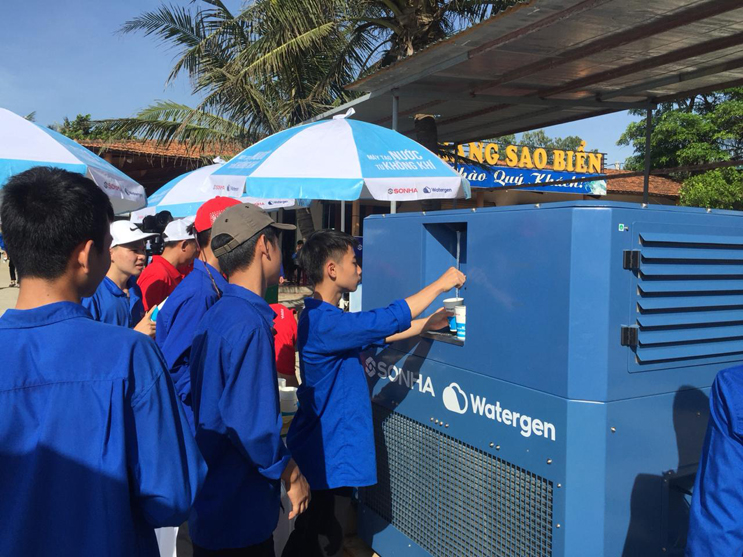Can Atmospheric Water Generation Help Solve The Global Water Crisis?
By Edward R. Russo
In areas where water, infrastructure, and resources are scarce, a natural and novel solution has emerged — arriving out of thin air, so to speak.
It’s no secret that we’re running out of water. By 2025, two-thirds of the world will face drinking water shortages.
Unfortunately, in many areas of the world, severe water crises have already begun.
The global initiative to promote safe and secure water encourages the decentralization of the supply and distribution of water. Atmospheric water generation systems can solve this problem and help sustain life moving forward.
National Geographic reports that only 1 percent of our planet’s water is drinkable and accessible, and over 40 percent has already been polluted through human and natural causes. More and more new and dangerous chemical compounds in the forms of fertilizers and antibiotics are being introduced into the world’s ecosystem every day.
Finding, identifying, and filtering these toxins from the world’s rivers, underground aquifers, and reservoirs has become a crucial and heretofore losing battle to keep water safe and drinkable for all living organisms on this planet.
Scientific and technical innovations have not developed fast enough or effectively enough to keep up with this ever-growing global tragedy.
Our existence depends on safe, secure, and available supply and distribution of water. Our global responsibility is to slow down the discharge of pollutants, speed up technical advances to remove toxins from our streams, rivers, and aquifers, and somehow provide the time to head off a global and irreversible human catastrophe.
We are losing this fight for our very existence.
"The technology finally exists today to provide people the ability to make their own water, safely and economically."
A New Approach
One recent initiative that has received global acknowledgment and support is the concept of using the water vapor in our atmosphere and converting the humidity directly to drinking water before it contacts ground-based pollutants.
Atmospheric water generation continuously produces water from air preserves, rather than depleting local water sources. Essentially, this technology is making rain in a box on-demand and ready for human consumption just about anywhere in the world.
Facts And Figures
- Water scarcity affects more than 40 percent of the global population, and that figure is projected to rise.
- Women in sub-Saharan Africa collectively spend about 40 billion hours per year collecting water.
- Each day, nearly 1,000 children die due to preventable water- and sanitation-related diseases.
- 663 million people are without access to clean drinking water.
- Water shortages, which increase disease and starvation, have already caused mass migration in areas that can no longer maintain a safe water source for crops and livestock.
- Traditional drinking water sources and treatment facilities such as aquifers and reservoirs have become too expensive to build, maintain, and protect.
"Atmospheric water generation does not try to make polluted water potable; it’s designed to make its own water off the grid."

An atmospheric water generation system in Vietnam
The technology finally exists today to provide people the ability to make their own water, safely and economically.
This global initiative of self-sustainability can now be integrated with advances in energy and food production, and can provide opportunities for off-the-grid homes.
It is imperative for the world to know that the safer and more secure a home or business is, the more valuable that environment will become.
“However, there are challenges to implementing a decentralized treatment strategy. Water reuse poses a serious engineering challenge: how to restore clarity quickly to fouled waters, enabling efficient final-stage polishing. Additionally, businesses often lack the people, money, and know-how to do so.” – Riggs Eckelberry, CEO, OriginClear (via wateronline.com1)
The Case For Water-From-Air
Other water treatment technologies have significant environmental influence and are becoming more expensive to operate. Bottled water creates concerns about byproducts, including plastic waste and trucking impacts.
Atmospheric water generation does not try to make polluted water potable; it’s designed to make its own water off the grid.
Clean water where it was otherwise inaccessible can bring the following community benefits:
- Improved health — Health costs will be lowered, as the availability of safe drinking water will eliminate illness and death caused by waterborne toxins.
- Improved education — Access to clean drinking water decreases illness and increases school attendance, enabling children to get educated.
- Empowered women — In undeveloped areas, women will no longer be burdened with the time-consuming search for drinking water from far-off locations, freeing them to pursue employment and a better quality of life.
- Reduced violence — Violence resulting from water retrieval and scarcity will be dramatically lessened.
Additionally, the decentralized aspect of atmospheric water generation creates the following benefits (via cleanwaterfund.org2):
- Lower costs for new infrastructure — New developments can be accommodated with targeted small-scale infrastructure that is cheaper than centralized infrastructure.
- Ecological restoration — Decentralized systems can reduce the discharge of pollutants, replenish aquifers, and restore stream flows and habitats.
- Resource efficiencies — Small-scale treatment units can save on energy costs and recycle nutrients into landscaping and agriculture.
- Community benefits — Green infrastructure has been shown to improve air quality, preserve open space, and create local jobs.
- Private financing — Small-scale treatment units on individual properties can be financed privately, thereby saving money for municipalities.
As children become more sensitive to toxins in the food we eat and the water we drink, it’s crucial to come up with innovations that will allow parents to be comfortable with the essential elements of life.
Surveys have shown that children are becoming more sensitive to these elements, and the growth of allergies is of great concern.
Having confidence in our food and water sources is imperative, and the best way to ensure food and water quality is to provide inexpensive and effective methods for a healthy future.
References
- https://www.wateronline.com/doc/the-water-revolution-moving-to-a-decentralized-system-0001
- http://www.cleanwaterfund.org/files/NewParadigmFactSheet1.pdf
About The Author
 Ed Russo is an environmental expert, author, entrepreneur, and a member of several voluntary and government boards. He serves as CEO of Watergen USA (WatergenUSA.com), President of the Florida Keys Environmental Coalition, Member of the Board of Directors of Reef Relief, Member of the Monroe County Climate Change Advisory Board, Member of the Board of Directors of the Florida Keys Community College Foundation, and Member of the Planning Board of the City of Key West.
Ed Russo is an environmental expert, author, entrepreneur, and a member of several voluntary and government boards. He serves as CEO of Watergen USA (WatergenUSA.com), President of the Florida Keys Environmental Coalition, Member of the Board of Directors of Reef Relief, Member of the Monroe County Climate Change Advisory Board, Member of the Board of Directors of the Florida Keys Community College Foundation, and Member of the Planning Board of the City of Key West.
